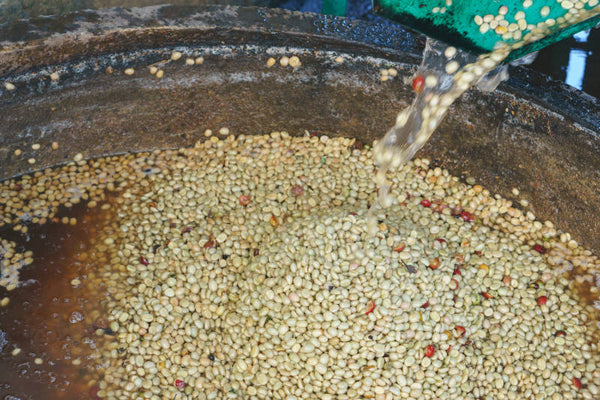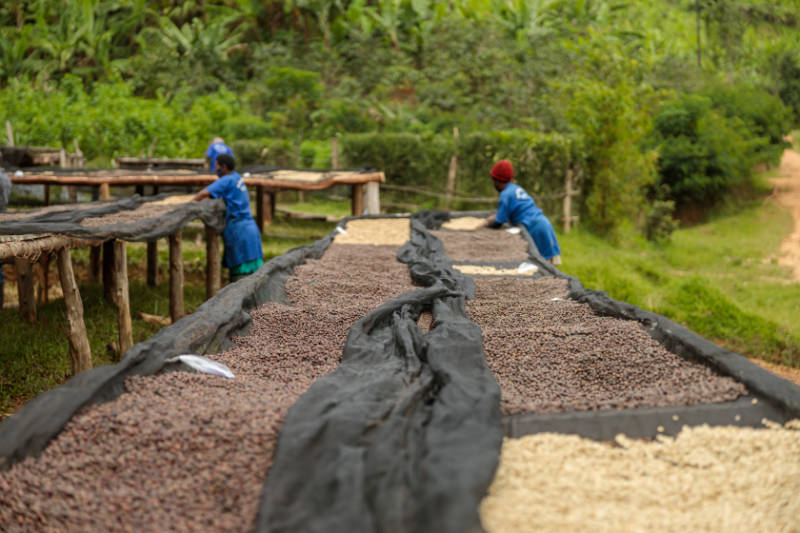Coffee processing
Initially, natural coffee processing was just a way to extract the beans from coffee cherries. No one thought much about the taste, because the processing methods were used only to allow coffee to be produced in their climatic conditions.
But after some time it became clear that the processing of coffee greatly affects the taste of the cup.
For example, with the same growing and brewing conditions, washed coffee will be more acidic than natural coffee.
That is why it is important to understand the differences between different processing methods and how they affect the taste.
Methods for processing coffee cherries

The cherry has six layers - skin, pulp, mucilage, parchment, silverskin and bean. Each of them performs its function: protects from the sun, damage and provides nutrition. The first 4 layers changes when coffee is processed.
There are four basic processing methods:
- Drying in the cherry, when the cherry is dried completely. This method called natural.
- Drying in the mucilage, when the cherry is dried without the skin and some of the pulp is removed. One of the most confusing methods, as it has many variations and can be called honey, pulp natural, semi-washed or semi-dry.
- Drying in a parchment, in which the skin and the pulp are removed, the bean is dried in a parchment. This method is called washed.
- Drying bean, when the skin, pulp and parchment is removed. This method is called wet-hull.
Often the processing method is chosen depending on weather conditions. If the climate is dry and hot, you can process coffee in a natural way. This method is also used due to low cost or limited amount of water, for example, in Ethiopia, Yemen and Brazil.
Other processing methods are more often used in humid climates. They allow you to dry the beans faster and avoid damage to the harvest.
Natural processing or why coffee becomes more sweet

Natural processing - the oldest way to extract the beans from coffee cherries.
This is a classic way of processing coffee beans. It has been used since the beginning of coffee production.
In Ethiopia and Yemen, where the climate is dry and there is no long rainy season, coffee cherries dried well in the open air.
In this process farmers dry coffee cherries on patios - concrete platforms or African beds - special tables with a grid. This usually takes up to four weeks. Some farms use special drying machines that are loaded with cherries after a few days in the sun.
The cherry dries along with the bean, the sugars from the pulp and mucilage remain in the bean. With the same terroir, roasting and preparation, natural processing gives the coffee a denser body and higher sweetness.
As a result of natural process coffee, we got the dried coffee cherries, which after are stored in special silos for some time to stabilize the taste and water activity. Then, before being sent to the customer, the dried cherries got hulled and the green beans are extracted and packed in export packaging.
All coffee was processed this way until it spread throughout the Europeans colonies.
Honey or Semi-washed. Why the pulp is removed.

The remains of the pulp give the bean different colors - from light yellow to almost black. Drying in mucilageis divided into two main groups - honey and semi-washed method. They are very similar, but there are differences.
Honey is a processing method in which the skin and part of the pulp are removed. Such cherries, when dried, get a honey color and become sticky. That’s why the method is called "honey".
Immediately after harvesting, farmers are doing depulpation, a stage in coffee processing in which the beans are separated from the skin and partly from the pulp. After that, the coffee is dried to a moisture content of 10-12%.
In half-washed processing after depulpation the coffee is sent to another machine - a demucifier. The machine removes the pulp almost completely, and only then the beans are sent for drying. This is the key difference from honey method, because there is almost no pulp left on the surface. With this method, the coffee dries even faster.
As a result of honey and semi-washed process we got the dried parchment - beans that covered with the last protective layer. The beans in parchment are also stored in special silos for some time to stabilize the taste and water activity. Then, before being sent to the buyer, the beans are sent to the hulling, where the green beans are extracted and packed in export packaging.
What else can this method be called: honey, honey, pulp natural, semi-dry, semi, half-washed, semi-washed, yellow honey, golden honey, black honey.
Washed processing: why it was considered better than natura

When beans are getting dried in the parchment, the pulp is removed by fermentation and then washed off with water.
This method was created when Europeans planted coffee trees in their colonies.
In Indonesia, Cuba and Central America, due to the humid climate, it was difficult to dry the cherries - the harvest could simply become moldy.
In addition, coffee consumption was on the rise, and it was important to figure out how to process it faster. In the 1850s, the British in their colony in Jamaica invented the washed processing method.
First, coffee cherries are depulped (peeled).
Then they are fermented. To do this, the cherries are left in the fermentation tank with or without water. Bacteria, yeasts and other microorganisms start the fermentation process and destroy the pulp and mucilage on the surface of the parchment.
After that, the remaining mucilage is washed off with water and the coffee is sent for drying.
Over time, the washed processing began to replace the natural: it was the only one that could be controlled, so the natural processed coffee turned out to be better in quality.
Under the same growing conditions, the same roasting and brewing, this method gives a cleaner and more acidic taste.
As a result of washed processing of natural coffee, as well as as a result of honey and semi-washed processing, we got the beans in the parchment, which are sent to storage in order to stabilize the taste and water activity. Then, before being sent to the buyer, the parchment is sent to the hulling, where the green beans are extracted and packed.
The biggest advantage of this method is that the drying time has been reduced greatly. It requires less space and in the end we get more clean and acidic cup.
The last method that we want to talk about is Wet-Hull.

A feature of wet-hull processing is the drying of beans without a parchment shell.
In wet-hall, the skin, pulp and parchment are removed from the cherry.
First, the cherries, as in the washed method, are hulled, fermented in the water and sent for drying.
The main difference is that the beans are dried to a level of 20-24%, although usually up to 10-12%. Then when beans are still wet they are sent to the parchment removal - halling. After parchment is removed, they dry faster.
As a result of wet-hull processing, unlike other processing, the green beans are immediately ready to pre-export preparation,then they are sorted, packaged and sent to customers.
Why is it important to know how coffee beans are processed
With different processing methods, different processes occur that affect the taste of coffee differently, so it is important to know them.
However, it is worth remembering that the terroir, type of coffee, roasting, grinding, water and other factors also affect the taste of coffee.

